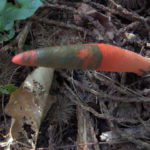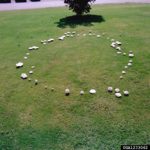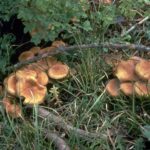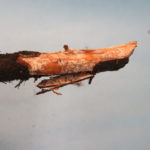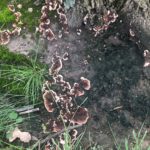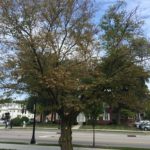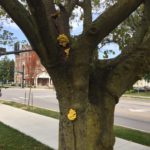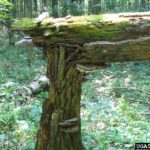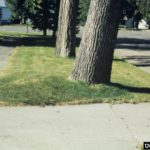Hunting for mushrooms is a fun past-time, even if you are not looking for edible fungi to “spice” up your cooking. However, when you see a fungal invader popping up in your lawn or landscape, they tend to be unwelcome inhabitants because they are launching sticky spore masses onto your siding, producing foul odors (Figure 1), could be eaten by your kids and/or dog, or its simply marring the aesthetic. Fungi are heterotrophs, meaning they cannot produce their own food, which is why when you find them popping up, you should be asking what are they eating?
- Figure 1: Stinkhorn growing from organic matter in a home lawn. (PPDL)
- Figure 2: Fairy ring in the landscape where a tree may have been planted. (Clemson University – USDA Cooperative Extension Slide Series, Bugwood.org)
If you see a fungal structure (conk or mushroom) developing near or on a shrub or tree, it is important to evaluate why it is there. Getting it identified can help you determine if it is a potential pathogen or just a happy little mushroom growing in your lawn. If it is growing directly from the shrub or tree, then you really want to figure out what it is and what potential harm it can cause to your tree.
Ecologically, fungi often fill the role of decomposers, breaking down already dead material. This is why you see stinkhorns, artillery fungi, and inkcaps growing in the mulch you placed in your garden. It is also the reason why you see fairy rings in your yard where you removed that tree stump 2 years ago (Figure 2). Some of these fungi will ride the line between decomposer and parasite. Armillaria, often called the honey fungus because of its color, is one such example where it can break down roots and stumps of dead trees, but it can also infect and kill stressed trees (Figure 3 and 4).
- Figure 3: Armillaria mushrooms growing from root system of an infected tree. (Mike Schomaker, Colorado State Forest Service, Bugwood.org)
- Figure 4: Large root of a declining Kousa dogwood with white mycelial fans under the epidermis, characteristic of Armillaria root rot. (PPDL)
Often an infection occurs because the tree was wounded or stressed by some previous event, but it has allowed the pathogen to gain entry and begin to spread (Figure 5, 6, 7). Subsequent disease caused by the invading fungus can lead to the death of the tree, but how the disease develops can be important in whether you want to remove the tree or keep it around for just a little bit longer. There are four different general types of rot, separated by the location they are found or tissue they affect: heart rot, butt (trunk) rot, canker rot, and root rot.
- Figure 5: Species of Ganoderma growing from the root and trunk of a Shumard oak. (PPDL)
- Figure 6: Yellowwood tree with obvious yellow color on the trunk. Note the canopy is thinning and showing signs of stress. (PPDL)
- Figure 7: Yellowwood from Figure 6, Infected by Laetiporus sulphureus (chicken of the woods). (PPDL)
Heart and canker rots are important because they can lead to the loss or dropping of limbs and a slow decline of the tree’s health. Butt rots and root rots are very important because they can do the same as heart and canker rots as well as affect the structural integrity of the tree. Loss of 10% of wood due to rot can lead to 70-90% loss in wood strength. If this occurs at the trunk of the tree, it can lead to breakage or toppling (Figure 8). When the roots are rotten, a tree is no longer able to anchor itself and is more susceptible to “windthrow” or being blown over (Figure 9). Trees with extensive internal rot may break or fall over on a calm day with relatively no wind. This is a real worry when the tree is near or towering over your house or could fall on someone on your property.
- Figure 8: Tree trunk snapping from extensive butt rot caused by Ganoderma applanatum. (Joseph OBrien, USDA Forest Service, Bugwood.org)
- Figure 9: Tree in foreground is tilting and shows roots pulling the up the grass prior to fully tipping over. (Peter Bedker, Bugwood.org)
Important take home: mushrooms growing on a tree can not only kill it, but may also reduce the structural integrity of trunk, branches or roots, which can lead to breakage or create a risk that the tree may fall. See a mushroom or conk? I recommend getting it identified and/or have a certified arborist assess the tree for structural instability.
